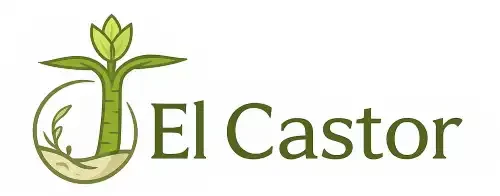Why is my terrarium moldy? This question lands in my inbox almost daily, usually accompanied by photos of once-pristine glass gardens now sporting unwelcome fuzzy white patches. The frustration is palpable, and I completely understand why this catches so many terrarium enthusiasts off guard.
Terrarium mold feels like a betrayal when you’ve carefully crafted what should be a self-sustaining ecosystem. Yet mold growth is actually one of the most predictable challenges in enclosed plant environments, and understanding why it happens puts you back in control of your miniature world.
Our question of June is: Is labradorite safe to use in damp terrariums?
Why is my terrarium moldy?
Your terrarium is moldy because it provides the perfect breeding ground for fungi: a warm, moist environment rich in organic matter with limited airflow. Mold thrives especially where there is moisture accumulation over long periods, and closed terrariums naturally maintain high humidity to keep the water cycle functioning.

The science behind terrarium mold is straightforward but important to grasp. Mold consists of multicellular fungal strands called hyphae that combine to form visible colonies known as mycelium, developing on dead or dying organic matter. Think of your terrarium as a miniature tropical environment where decomposition happens rapidly—exactly the conditions mold spores need to flourish.
Understanding what triggers mold growth
Several interconnected factors create the perfect storm for mold development in terrariums. High humidity, stagnant air, and insufficient light contribute to mold proliferation, while mold spores can enter via soil, plants, mosses, and even the air.
Moisture management issues top the list of mold triggers. Because terrariums have no drainage holes, you must be extremely careful with watering amounts. When excess water can’t escape, it creates standing water conditions that mold absolutely loves. I’ve seen countless terrariums where well-meaning plant parents overcompensated with water, thinking more moisture equals healthier plants.
Poor air circulation compounds moisture problems. While terrariums need humidity, they also require proper airflow to prevent mold growth. Sealed environments without periodic air exchange become stagnant, allowing mold spores to settle and establish colonies undisturbed.
Contaminated materials introduce mold directly into your ecosystem. Adding biodegradable decorations like sticks, pine cones, or seed pods means introducing materials that will quickly degrade in humid conditions. Even soil that hasn’t been properly sterilized can carry dormant spores ready to activate.
Recognizing different types of terrarium mold
Not all mold looks the same, and identifying what you’re dealing with helps determine the best approach. White mold (Aspergillus and Penicillium species) appears as white or gray fuzzy growth and represents the most common terrarium mold type, growing rapidly on soil, plants, and decorative materials.
Black mold (Cladosporium and Alternaria) appears darker and typically shows up on plant leaves and branches, while pink mold (Fusarium) targets soil and root systems, potentially damaging plant health directly. Slime mold (Rhizopus) creates white or gray slimy textures and grows rapidly on decomposing organic materials.
Each type indicates different underlying issues. White mold usually signals general moisture and ventilation problems, while black mold on leaves suggests poor plant health or excessive humidity. Pink mold around roots points to soil drainage issues requiring immediate attention.
Preventing mold before it starts
Smart prevention beats reactive treatment every time. Choose containers with good drainage capability, add activated charcoal layers, use well-draining terrarium-specific soil, and sterilize all materials including plants, stones, and decorations before assembly.
Proper layering forms your first line of defense. Create a drainage layer using sand or rocks at the bottom, followed by a divider (coffee filter or cheesecloth), then an activated charcoal layer before adding your growing medium. This system prevents standing water while the charcoal absorbs impurities and helps eliminate odors.
Material selection matters enormously. Using substrates like coco coir, which is made from ground coconut husks, reduces mold risk compared to traditional potting soils. Always start with clean containers washed in hot soapy water, and consider sterilizing soil in the microwave before use.
Environmental controls keep conditions balanced. Ensure adequate lighting, whether natural sunlight or artificial sources, as mold tends to favor darker spots. For closed terrariums, open the lid once weekly for about 24 hours to promote air circulation.
Treating existing mold outbreaks
When mold appears despite your best prevention efforts, swift action prevents spread. Address mold issues promptly since mold proliferates rapidly in enclosed environments, potentially spreading to other plants and harming the terrarium ecosystem.
Physical removal represents your first intervention step. Use cotton swabs, paper towels, or specialized tools like tweezers to gently remove surface mold, cutting away mold-affected branches and leaves close to plant stems. Dampen moldy areas slightly before removal to minimize airborne spore release.
Natural treatment options provide plant-safe solutions. Natural remedies like hydrogen peroxide, baking soda solutions, or cinnamon offer preferable choices over harsh chemicals. Apply these carefully with spray bottles or cotton swabs, ensuring proper dilution to avoid plant damage.
Environmental adjustments address root causes. After mold removal, leave the terrarium open to air dry before resuming normal watering schedules. Evaluate your watering frequency, lighting conditions, and ventilation practices to prevent recurrence.
Creating a bioactive mold prevention system
The most effective long-term mold prevention involves establishing a bioactive ecosystem. Adding beneficial organisms like springtails creates a natural cleanup crew that specifically targets mold as their primary food source.
Springtails as mold controllers represent nature’s solution to your mold problems. These tiny creatures feed primarily on fungi and bacteria, with springtails being the single best solution to tackle mold in terrariums. Springtails actively prevent mold from maturing and eliminate the need for manual intervention, which can inadvertently spread mold spores.
Implementation is straightforward. Springtail cultures typically come with charcoal substrate that can be added directly to your terrarium, or you can rinse the springtails and introduce them to your existing setup. These organisms self-regulate their population based on available food, requiring virtually no maintenance while providing continuous mold control.
Additional bioactive elements enhance system stability. Combining springtails with isopods creates an effective tag-team cleanup crew, though springtails handle mold specifically while isopods process larger organic debris. This combination creates a truly self-sustaining environment.
Monitoring and maintaining mold-free terrariums
Regular monitoring prevents problems from getting out of hand—check your terrarium at least weekly, taking just seconds to look for any developing issues. Consistent monitoring remains vital since mold recurrence is possible even after treatment.
Watch for early warning signs: persistent condensation on glass walls, musty odors, or small white patches appearing on soil or plant material. Remove water droplets and condensation from glass sides promptly, as constant high humidity levels lead to fungal growth on soil and plants.
Seasonal adjustments help maintain balance. During humid summer months, increase ventilation frequency. In dry winter conditions, monitor for adequate moisture while ensuring proper air circulation. Your terrarium’s needs shift with environmental changes, and staying attentive prevents major issues.
Conclusion
Last month, I discovered white fuzzy patches spreading across the moss in my favorite woodland terrarium—the one I’d been nurturing for over two years. Instead of panicking, I immediately introduced a springtail culture and adjusted my ventilation schedule. Within a week, the mold disappeared completely, and my miniature forest returned to its pristine state. This experience reminded me why I’m so passionate about teaching proper terrarium science: understanding the “why” behind mold growth transforms it from a terrifying mystery into a manageable challenge that actually strengthens your skills as an ecosystem architect.
El Castor is your exclusive terrarium guide.
